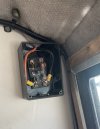- Joined
- May 10, 2020
- Messages
- 87
- Reaction score
- 9
- Points
- 8
- Age
- 56
- Location
- Far Rockaway, NY
- Model
- Seafarer
I found this odd corroded ... what appears to be a junction box in the port side in the cab of my 1987 seafarer 228
what would you replace it with. I am planning on a full rewire soon. I'm not sure why there is a fuse on both the positive and negative on this.
according to the original manual "
Auxilliary Fuse Panel: located under the dash, the auxiliary fuse panel offers the ability to hook additional electronics....note a set of 10 gauge wires (orange and black) running from the panel
These wires terminate at a junction box on the port side. This junction box offers convenient access to power for electronics install don the port side."
what do I replace it with?
two terminal blocks? https://defender.com/en_us/cole-hersee-terminal-block
a fuse block? https://defender.com/en_us/blue-sea-systems-st-blade-6-fuse-block-with-common-negative-bus-5025
or a junction box?

 defender.com
defender.com
 www.fisheriessupply.com
www.fisheriessupply.com
or just forget it until I need it?
what would you replace it with. I am planning on a full rewire soon. I'm not sure why there is a fuse on both the positive and negative on this.
according to the original manual "
Auxilliary Fuse Panel: located under the dash, the auxiliary fuse panel offers the ability to hook additional electronics....note a set of 10 gauge wires (orange and black) running from the panel
These wires terminate at a junction box on the port side. This junction box offers convenient access to power for electronics install don the port side."
what do I replace it with?
two terminal blocks? https://defender.com/en_us/cole-hersee-terminal-block
a fuse block? https://defender.com/en_us/blue-sea-systems-st-blade-6-fuse-block-with-common-negative-bus-5025
or a junction box?

Scanstrut Standard Junction Box - SB-8-5
The Scanstrut "fit and forget" Junction Box provides secure, watertight connections for marine electrical cables onboard any boat, making it the perfect sailing accessory for anyone planning boat maintenance. Features: Secures, watertight connections
Newmar PX1 | Fisheries Supply
Save More on Your Newmar #PX1 Newmar Waterproof Junction Boxes, 5 Cable Entries (6 Gangs) 2.95" x 2.95" x 1.66" at Fisheries Supply. Excellent Customer Service, Ready to Ship. Marine Supplies Since 1928!
or just forget it until I need it?


